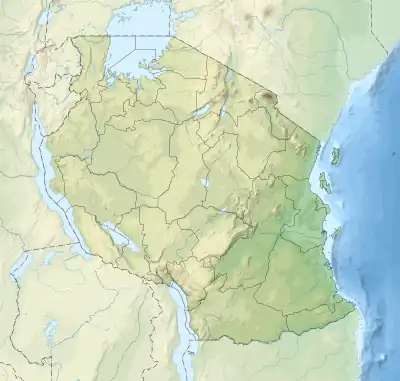Udzungwa Mountains National Park
The Udzungwa Mountains National Park (Hifadhi ya Taifa ya Milima ya Udzungwa, In Swahili) is a Tanzanian national park in Kilolo District of Iringa Region and Kilombero District of Morogoro Region. The park is mostly located in Kilolo District. It has a size of 1,990 km2 (770 miles2).[1] The habitats contained within the national park include tropical rainforest, mountain forest, miombo woodland, grassland and steppe. There is a vertical height range of 250–2,576 metres (the peak of Lohomero), which incorporates the Udzungwa Mountains part of the Eastern Arc Mountains.[2] There are more than 400 bird species, 2,500 plant species (25% of which are endemics) and 6 primate species. It has the second largest biodiversity of a national park in Africa.[3][4]
| Udzungwa Mountains National Park | |
|---|---|
 Waterfalls in Udzungwa Mountains National Park | |
 Location of Ugalla River National Park in Tanzania | |
| Location | Kilolo District of Iringa Region & Kilombero District of Morogoro Region |
| Nearest city | Morogoro |
| Coordinates | 7°48′0″S 36°41′0″E |
| Area | 1,990 km2 (770 sq mi) |
| Designation | National Park |
| Established | 2012 |
| Named for | Udzungwa Mountains |
| Governing body | Tanzania National Parks Authority under the Ministry of Natural Resources and Tourism |
| Website | Official Page |
Endemism
Six primate species have been recorded in the park, five of which are endemic. The Iringa red colobus, Udzungwa red colobus and Sanje crested mangabey are only found in the Udzungwa Mountains National Park, the mangabey species was undetected by biologists prior to 1979.[5] A new endemic species of chameleon was discovered in 2009 in the national park.[6]
Activities
Tourism in the Udzungwa Mountains national Park revolves around hiking and trekking, as the park has no roads and is accessible only on foot. The hiking trails range in difficulty from the short one-hour Sonjo trek to the extremely challenging 6-day camping trek the Lumemo Trail. The most common walk is the Sanje Falls trail which takes approximately four hours to complete and allows the visitor access to the stunning 170 m waterfall and includes swimming in the waterfall plunge pools as part of the activity.[7]
Accommodation for visitors within the park is only possible on a camping basis as there are no lodges within the park borders. Within the nearby village of Mang'ula there are also a couple of local guesthouses providing a budget option.[8]
Image gallery
 A view from the top of the park.
A view from the top of the park. Numerous mangabey monkeys inhabit the park.
Numerous mangabey monkeys inhabit the park. Trees in the park.
Trees in the park.
References
- "Udzungwa Mountains National Park". Tanzania National Parks.
- Lovett, Jon C., Andrew R. Marshall, and Jeff Carr. "Changes in tropical forest vegetation along an altitudinal gradient in the Udzungwa Mountains National Park, Tanzania." African Journal of Ecology 44.4 (2006): 478-490.
- "Udzungwa Mountains National Park". Tanzania National Parks.
- Lovett, Jon C., Andrew R. Marshall, and Jeff Carr. "Changes in tropical forest vegetation along an altitudinal gradient in the Udzungwa Mountains National Park, Tanzania." African Journal of Ecology 44.4 (2006): 478-490.
- Araldi, Alessandro, et al. "Density estimation of the endangered Udzungwa red colobus (Procolobus gordonorum) and other arboreal primates in the Udzungwa Mountains using systematic distance sampling." International Journal of Primatology 35 (2014): 941-956.
- Menegon, Michele, et al. "A new species of chameleon (Sanria: Chamaeleonidae: Kinyongia) from the Magombera forest and the Udzungwa Mountains National Park, Tanzania." African Journal of Herpetology 58.2 (2009): 59-70.
- "Udzungwa Mountains National Park". Tanzania National Parks.
- "Udzungwa Mountains National Park". Tanzania National Parks.